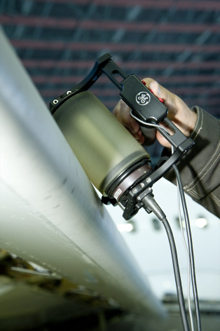Marine Results has developed a new Non Destructive Testing (NDT) procedure using a custom built ultrasound wheel probe supplied by GE Sensing and Inspection Technologies. The 0.5 MHz RotorArray uses a form of ultrasound testing known as phased array, where the ultrasound beams can be electronically controlled to detect, image and size defects in yacht structures including hulls, masts and rigging. Combined with Marine Results latest portable phased array equipment the RotorArray allows the inspector to more easily inspect larger areas with the ability to record an image of the underlying structure of hulls, boom and masts. The system can be used to find a number of manufacturing and in-service defects including skin to core delamination, blisters, and impact damage.
The inspection technique has been designed by Marine Results’ associate Richard Freemantle who has previously used the method for the inspection of cored laminates typically used in the aerospace industry. “A grand prix racing yacht like a TP52 or Volvo 70 hull would benefit from inspections using the phased array wheel probe to get a picture of what is going on inside the composite structure,” explains Richard. “The system automatically collects the ultrasound data as we scan and the resulting baseline NDT images can then be used to guide future inspections of the structure and monitor its integrity.”
The wheel probe scans a section of laminate of up to 128mm in width in a single pass and can be used on carbon and glass fibre monolithic laminates, as well as a wide range of cored laminates. Marine Results have already conducted a number of inspections using this technology, focussing on quality assurance of new builds that have large sections of thick monolithic and cored laminates.
“Acquiring this Wheel Probe, which gives repeatable and detailed data, is another major step in our NDT technology development for vessel inspections,” comments Ed Danby of Marine Results. “The wheel probe will be a powerful tool for inspecting new builds compared to more traditional methods like tap testing.”

